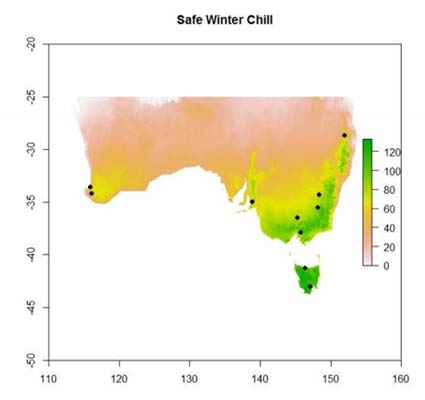Accumulating sufficient chill (continued from last month)
This year, accumulating sufficient chill should not be a problem at any of the sites in the project.
Currently in Tasmania most cherry producing sites have reached at least 80CP, with other sites also following historical averages.
Figure 5 shows a map of reliable chill accumulation ‘safe winter chill’ across southern Australia for 101 years of historical data. Generally, Tasmania is above 100 chill portions; Victoria, eastern NSW and the south east corner of QLD range from 60 to 100 chill portions; and WA is less than 70 chill portions.
What happens if climate and chill accumulation changes—what can we do?
In recent years there has been much experimentation in the use of rest breaking agents to promote budburst, and to compact and advance bloom and harvest.
Results to date have been inconsistent (and now that we know the difficulties in quantifying chill, knowing that we don’t know when dormancy really starts and ends, and lacking good information on chill requirements by variety—then this is not surprising).
Rest breaking agents
Knowing when to apply rest breaking agents is key.
Some recommendations are at 60–80% of the chill requirement (but do we know how much chill is enough for each variety?), at a set period before expected budburst, or at particular chill accumulation.
This project looked at the impact of Dormex® (a rest breaking agent) on bud burst and flowering times (Figure 6). Compared to no Dormex application, bud burst (green dot) was four days earlier in Kordia, and even earlier in Van.
Full bloom (red dot) was slightly earlier than normal in Kordia but more than 10 days earlier than normal in Van.
There was little difference noted in Lapins.
Although the data indicate that timing is advanced with this product, a condensing of the flowering period was not as obvious. The physiological process that Dormex acts on is not clear.
Using current understanding, Dormex should have nil or little effect in high chill zones as they more than exceed varietal chilling requirements. These results indicate that there is a response in high chill areas in Tasmania. So maybe Dormex is influencing bud susceptibility to warm temperatures rather than overcoming insufficient chill.
Hence, using it to adapt to low winter chill conditions may not have the desired outcomes and other alternatives should be investigated.
Finding strategies
Finding strategies for adapting to warming temperatures is needed.
Regions such as California’s Sacramento Valley, south-east USA, Central Valleys in Chile, Yunnan Province in China, and south-west Australia are all projected to experience warmer temperatures and reduced winter chill.
Chile has also highlighted additional issues of water availability and out-of-season frost. California has reported low chill for the last two seasons resulting in reduced yields.
More information
For more information see the links provided (left), especially the University of California resource page.
Research reports on calculating chill, comparison of impacts of rest breaking agents (and urea) on bud break and flowering, optimising nitrogen availability for yield and quality, and effects of BlueStim on cracking can be found.
Also, the Horticulture Industry Network page (left) has some great resources around chill. Some of them have been derived from the ‘Crossing the threshold’ project.
See this article and contact details in Tree Fruit Dec 2015






















